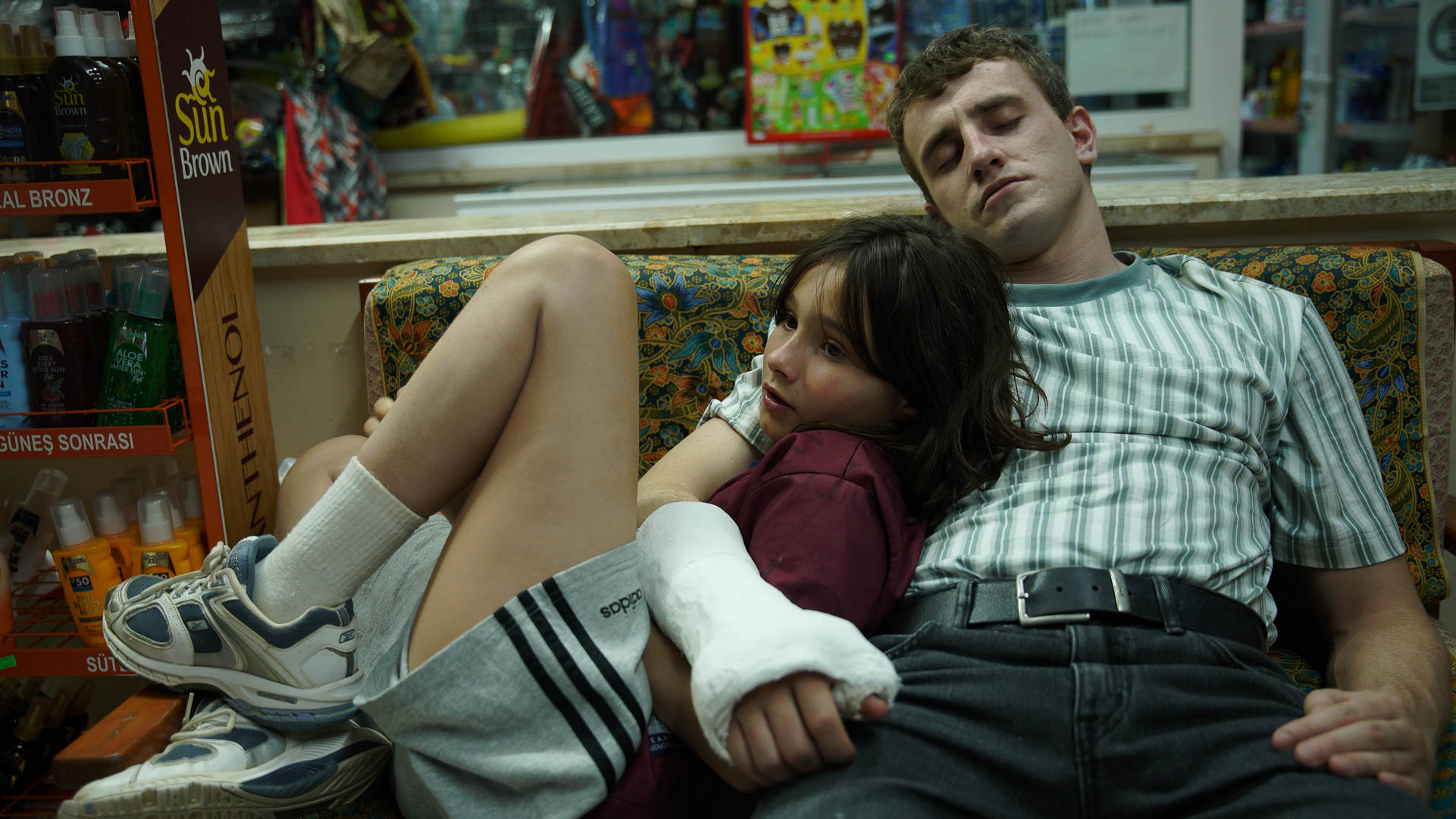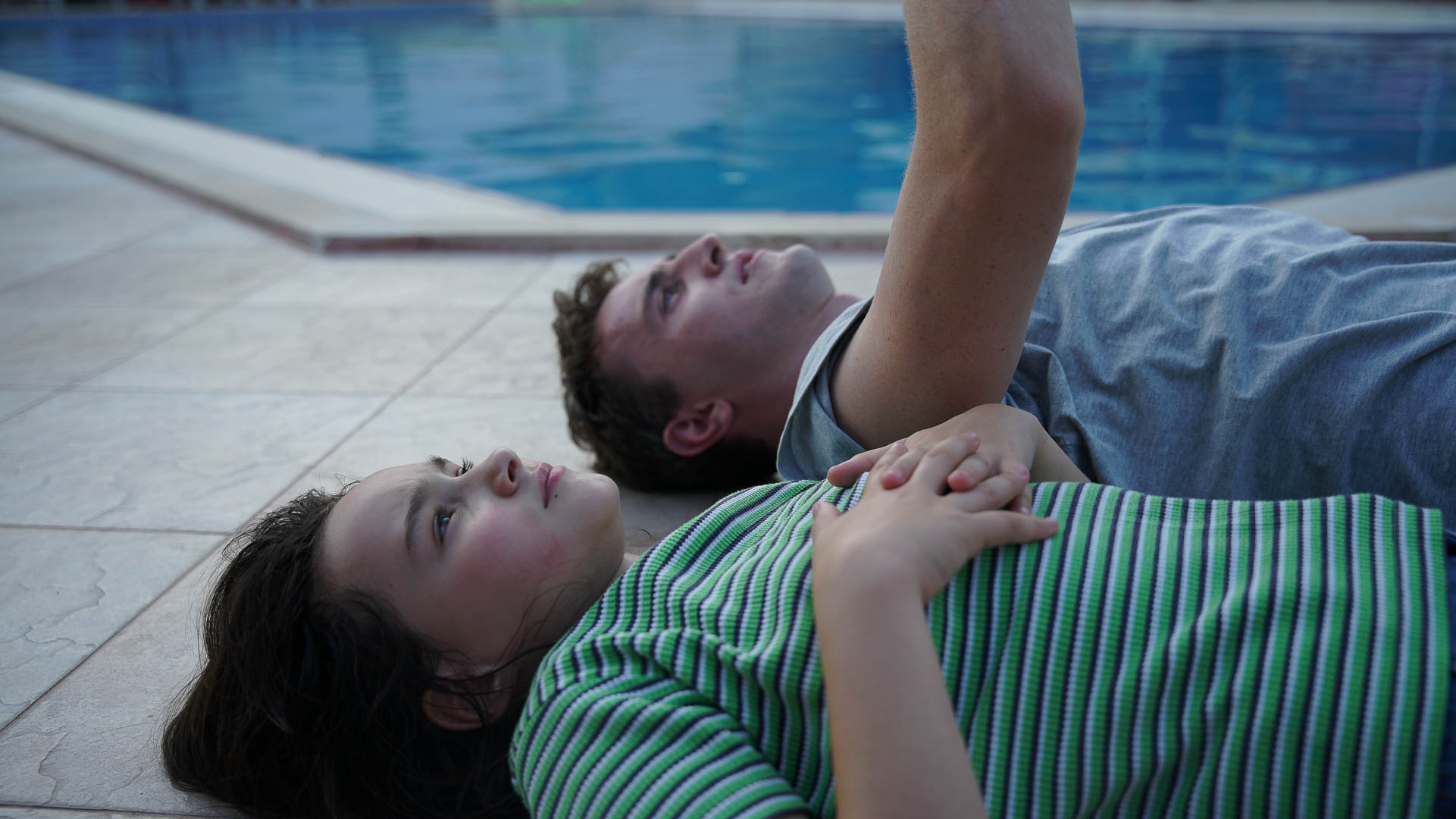Aftersun and the Great Unknown

Critics Campus 2022 participant Lily Rodgers examines the calibrations of suggestion, subtlety and reticence in Charlotte Wells’s Aftersun.
An 11-year-old groans in embarrassment as her father playfully grooves on a dancefloor to David Bowie and Queen’s ‘Under Pressure’. A moment later, the same girl (now grown up) barrels towards her father (who has not), lit only by the staccato pulses of strobe lights. Her mouth opens to a yell that is inaudible and she hugs him tightly as the song’s lyrics repeat, “This is our last dance.” The debut feature of Scottish filmmaker Charlotte Wells, Aftersun uses moments like this to probe the complexities of human relationships that cannot be expressed in words.
Inspired by old holiday photographs, Aftersun is a film about looking back and attempting to fill in the blanks of what you were too young to realise at the time. Produced by Moonlight’s Barry Jenkins and Adele Romanski, the story follows adolescent Sophie (newcomer Francesca Corio) on vacation in Turkey with her divorced dad, Calum (Paul Mescal, Normal People), who is young enough to be mistaken for her brother.
Aftersun’s overarching perspective is that of the adult Sophie as she rewatches camcorder footage from the holiday. While the film is incredibly open, visual clues like the plaster cast around Calum’s wrist, dialogue in which he claims he “can’t imagine [himself] at 40” and his notable absence from scenes involving the now-grown-up Sophie (Celia Rowlson-Hall, Vox Lux) suggest tragedy in the intervening years. As such, Sophie’s ruminations on this holiday can be seen as an attempt to read between the lines of her past in a bid to understand her father, even if such understanding ultimately remains elusive.
Aftersun extends the style that Wells has developed in short films like Laps (2017) and Tuesday (2015), which foregrounds minute observational details, communicates through implication, and creates a degree of distance between the audience and the characters. The camcorder footage interspersed throughout – of Sophie trying on glasses, interviewing Calum and ‘reporting’ to a swivelled-around camera that catches only her mouth – feels like authentic documents of a family holiday. Even the more conventional cinematic images mimic the aesthetic of this camcorder footage through frequent use of zooms, close focus on isolated facial features, and fluid, handheld movement, which imbues the entire film with a potent sense of nostalgic yearning.

Aftersun
Although Sophie lives with her mum, the breezy rapport between Corio and Mescal allows the film to depict a deep sense of intimacy between father and daughter. Their dialogue is natural; their touches, instinctive and familiar; and they seem to light up in one another’s presence. Mescal’s warm presence is captivating, especially given the film’s suggestions of a troubled psyche beneath his easygoing exterior. Similarly, Corio is a natural in front of the camera, capturing the awkward blend of boldness and self-consciousness of children on the cusp of puberty.
Capturing that transitory moment when the adult world begins to unfurl before our eyes, Wells focuses the camera on subjects that highlight Sophie’s curiosity about the behaviour around her. She watches a man rub sunscreen on a woman’s back, a group of tourists smoking, an older girl ordering a beer. In one moment, she jumps into a swimming pool with a group of teenagers and observes from beneath the surface as they desperately claw at each other’s limbs, at once fascinated by and struggling to make sense of the exploits of her older counterparts.
Two-thirds of the way into the film, we are introduced to adult Sophie. This disruption of the film’s linearity so late in the game is a bold choice, yet it feels entirely natural due to the visual details that Wells focuses on throughout, which hint at a more adult perspective.
In an early sequence, the camera slowly zooms from Sophie asleep in the hotel bed to Calum smoking a cigarette on the balcony and swaying by himself. There is a kind of restless turbulence in this movement that we can’t quite make out. Indeed, much of what the audience learns about Calum is implied rather than explicitly stated or explained. In keeping with this, Calum often evades the direct gaze of the camera. In one shot, we see only his arm; in another, a slight sliver of the left side of his face. Even in one of the most emotionally intense scenes of the film – wherein an image of Calum watching Sophie sing ‘For He’s a Jolly Good Fellow’ for his birthday fades to him sitting on the edge of the bed, weeping – Mescal is shot from behind. The audience is not given access to his face, just his bare back shaking as he sobs. Wells has mastered the art of suggestion, including enough details to insinuate foreboding around Calum’s future, but allowing the audience to connect the dots themselves. There is tremendous pathos generated from such unfulfillable desire to know this man.
In the final moment of the film, camcorder footage of Sophie waving goodbye at the airport swings around to show Calum holding the camera as he watches her go. In a disruption of Wells’s visual style up to this point, he is centre frame. He looks up and, for a split second, emotion runs across his face: a flicker of hope, desire, fear … But he turns back and walks away, disappearing behind a door that, in a surreal twist, leads to only darkness and strobe lights. Forever unknown.